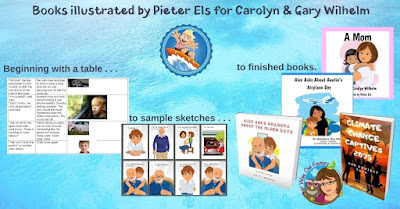 |
| "The key is not spending time, but in investing in it." Stephen R. Covey |
What is the first thing you want to do in the morning when you get up? If you’re like me, you want to write. But there are so many other things to do, even for retired folks like me! Often, writing—composing—doesn’t happen until nighttime when the dishes are done and the house is quiet.
Throughout the day while wishing I could be writing, I dream. My dream goes something like this (in order of preference):
I could write right now if only I had:
- an on-call massage therapist
- a nanny (when I still had kids at home)
- a maid
- a cook
- a secretary
- a research assistant
- a dedicated media specialist
- an errand runner
- a personal trainer
- a gardener
- a dog walker
Then when nighttime comes, I realize I am all those things. I do something from most if not all the items on my list every day.
Make Your Life Your Inspiration
A humorist writer friend of mine once told me about challenges her husband faced at his job. About what was going on with each of her three sons. About her own life and lack of time to get anything done.
But she told me she wouldn't trade her life for the world. If it weren't for the angst in her family, she wouldn't have anything to write about.
I've never forgotten my friend’s insight. It's a lesson I cherish every day. If I had too much time to write, my need wouldn't be as urgent. I may not be as motivated. I may not have those few hours of pure bliss to look forward to each day.
Once I tried doing nothing but write all day, every day. I soon found that my life became so narrow, the energy I had once stored up for writing projects had withered away. I ran out of ideas. My page became as blank as my life.
Balance. That is the answer. Find a proper balance and that will solve everything. Good luck with that. Balance turned out to be as fleeting as my sapped energy. I discovered lopsided is good. My solution: create space to write. Take time out each week to work on writing projects. Though even this plan sometimes seems impossible, if we stick to a schedule, no matter how small it may be at times, eventually we will finish our projects and go after publishing our work.
Gains and Losses
Since recently “putting to bed” a few book projects, I realize I am teetering on the brink of marketing them and jumping into my next writing project(s) with both feet. Here is the short version of what has happened to my life as I endeavor to reach my future writing goals.
Gains:
- The many friends and acquaintances I've made that will surely remain a part of my future.
- The sharpening of my skills.
- Learning new things every day.
- Being motivated enough to stay up late and still get up early.
- The fun of sharing my hopes and dreams with others.
- The feeling of accomplishment at completing such a challenging task as writing a book.
- Keeping other interests alive to strive for less lopsidedness and more balance.
- How much I've grown from reading and learning about different people and subjects.
- Emotionally I feel I've grown, too, for it seems that understanding our own emotions and others' emotions is part of writing.
- Being an entertainer.
- The sheer fun of having an audience.
- Enjoying the feeling of joy inside at all that writing has given me.
Losses:
- No more time for sewing or photoscrapbooking.
- Little time for socializing; having to say no to invitations to join clubs, play bridge, or loll around the pool.
- Free time to simply curl up with a good book or watch TV, or do nothing.
- Everything I do has to have a purpose in order to squeak out time to write.
Live a Life of Gratitude
The list of gains is long, losses is short. Like my humorist friend, I wouldn't trade this life for anything. Let us be grateful for the lives we've been given, which have brought us so willingly to the page and all we’ve gained from it, over and over again.
Photo: By Linda Wilson
For more about time management visit: https://www.actitime.com/time-management-guide/time-management-covey-matrix
Secret in the Mist, Book 2
of the Abi Wunder Mystery series
will be available soon.
Linda Wilson lives in Albuquerque, New Mexico. She has two daughters who inspired her stories when they were younger. Linda is the editor of the New Mexico Society of Children’s Writers and Illustrators newsletter, and has written posts for the Writers on the Move blog since 2013. She is a classical pianist and loves to go to the gym. But what Linda loves most is to make up stories and connect with her readers. Find out more by visiting Linda’s website at https://www.lindawilsonauthor.com.




















